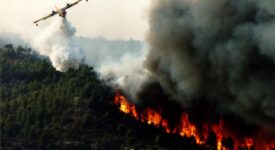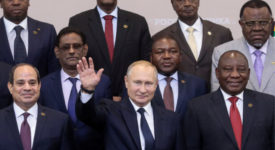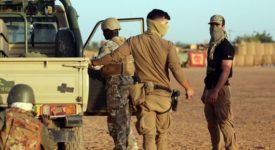The fall of Kabul has taken Afghanistan and counterterrorism experts and non-experts alike by surprise. Commentators were quick to draw parallels with the Sahel and cast ominous premonitions on the fate of a region doomed to be next in the “Western clusterfucks agenda”. On 15 August, the Financial Times published an editorial of Nigerian President Buhari himself, warning the international community not to lower its guard as a new front of the global jihad has opened in Africa, suggesting that the War on Terror (WoT) cannot die in Kabul but should instead evolve and shift its focus towards Africa. Now Buhari, two-time Nigeria’s President, is not exactly a sloppy, inattentive observer. He frames Africa and the Sahel as places where the threat should be managed, disciplined, and contained, feeding into those interpretative security schemes that have characterized the WoT since 9/11. Nonetheless, this interpretation is based on a fallacious assumption: the WoT has indeed been waged in Africa since its inception and has profoundly shaped its political and security dynamics.
The Sahel is a case study for understanding how twenty years of international interventions and counter-terrorism policies have transformed local conflicts and Africa’s political and social landscape as a whole. November 2002 can be identified as the starting moment of the WoT in the Sahel, when the US Department of Defense (DoD) announced the launch of the Pan-Sahel Initiative, a program aiming at securing borders, tracking the movement of people, and fighting terrorism in Mauritania, Mali, Niger, and Chad. The initiative officially inserted the Sahel into the War on Terror, in accordance with and applying the cognitive and normative schemes of threat assessments characterizing this global security framework. Indeed, even if jihadist insurgents’ de facto activities had not been recorded in the area yet, the very characteristics attributed to that space – vast stretches of “ungoverned lands” open to the penetration of transnational terrorists and criminal actors – justified the security intervention in the Sahel; paving the way for successive developments.
In the years that followed, the Sahel gained growing international attention, and the security initiatives in the area multiplied. Mali in particular emerged as one of the only accomplished democracies in Western Africa, becoming the center of the security strategies of its Western allies. The country started receiving increasing amounts of developed aid and full material support for its security forces, presented as the frontline “warriors” of the WoT in the area. Nevertheless, behind a smokescreen of democratic rule and stable institutions, the effective system of governance in Mali was mostly characterized by a dangerous mix of neopatrimonialism, corruption, cooptation of criminal and non-state armed actors, and repression of those marginalized communities less keen to accept the predatory rule of the regime in Bamako, starting from the Tuareg. In parallel with this, starting from 2003, former members of the Algerian GIA who had founded the GSPC in 1998 moved to northern Mali. By implementing a complex strategy of settlement and capital accumulation based on the creation of a “kidnapping industry” targeting Western citizens in the area, on a contingent yet stable collaboration with different criminal groups, and on the creation of linkages with local communities through marriages, the group finally managed to establish itself in northern Mali and beyond, conducting attacks from Mauritania to Niger.
Against this backdrop, the international presence and security initiatives represented a veritable game changer, furthering and deepening the multidimensional crisis in the Sahel. On the one hand, they indirectly legitimated the GSPC’s claims of being the local fighters of a global war against the invaders and the apostates: the group officialized its bay’ah to al-Qa’ida, rebranding as al-Qa’ida in the Islamic Maghreb (AQIM) in 2007. On the other hand, international aid and security cooperation reinforced the dysfunctional system of governance created by local regimes, furthering those political mechanisms that fostered popular grievances against their governments, ultimately paving the way for the collapse of the Malian state in 2012 and the spread of the jihadist insurgency across the Sahel.
In early 2012, Touareg rebels — supported by members of several jihadist groups began a secessionist offensive, the fourth Touareg rebellion, in the north of Mali. Then a subsequent coup in Bamako led to a political crisis, the collapse of the army, and the northern rebellion announcing the creation of the Islamic Republic of Azawad. Concerned with the progressive worsening of the security situation and the expansion of the jihadist threat into the south of the country, France launched Operation Serval in January 2013. The operation successfully cleared several cities in the north and contained the insurgency. In July 2013, the MINUSMA mission, accounting for nearly 12,000 peacekeepers, was deployed to help the government reassert authority in the north and assist the peace process. However, the interconnections that have consolidated over the years between illicit activities – such as trafficking in drugs, weapons, and human beings as well as artisanal gold mines exploitation – and rebel financing continued after the peace agreement signed in 2015 and will likely continue during and after the transitional government was established following the latest coup in August 2021.
Why are international observers so scared? Through a process of germination that dates back directly to the northern Mali’s rebellion, nowadays two of the most powerful franchises of al-Qaeda and the Islamic State worldwide operate in the Sahel. The phenomenon of the insurgency can be framed both within local and global logics as a “glocal” epiphenomenon, where micro-local societal realities are grafted onto a would-be-global jihadism. The local dimension of the insurgencies is central as — to varying degrees — the insurgencies have been proven more skillful at exploiting local grievances, especially regarding abuses by the security and defense forces, precisely those who are supposed to protect the population in the first place. At the same time, as it happened in Mali ten years prior, international actors have been key in favoring the “success” and the expansion of these insurgencies. While the international approach has been framed within the security-development nexus, the binomial has been lopsided on security. Militarizing and securitizing the Sahel has meant throwing down the drain the “reinforcing local governance” narrative, ultimately strengthening the same dysfunctional institutions and elites that further the local population’s grievances.
Reinforcing the EU security dispositifs deployed in the Sahel (EUCAP, EUTM) has been functional to regulate migration, an alleged specter looming over Europe, while counterterrorism efforts (Barkhane, G5 Sahel, MINUSMA) were intended to strike out jihadists’ leaders and bring back “good governance”. However, the hollowness of the “good governance” talk in the Sahel — and the international community’s intrinsic bias towards technical approaches — has made a laughing stock of the approach based on “tackling ungoverned spaces as breeding ground for terrorists”. The self-fulfilling prophecy became true as, there are now jihadist insurgents governing those spaces. In the meantime, after almost a decade, the EU revised its strategy towards the Sahel in April 2021, seemingly having listened to what policy analysts have been repeating to the point of exhaustion for the past decade. The EU has finally acknowledged the need to fill its governance talk with meaning, especially with regards to the contribution of civil society, fighting impunity, and a more nuanced understanding of the role that security forces play.
Meanwhile, Macron’s announcement of Barkhane’s withdrawal by the end of 2022 — the largest CT force in the Sahel — bearing in mind the abrupt fall of Afghanistan, worries many commentators, who hope that what bolstered local insurgencies in the first place won’t be the final straw that ensures their territorial control and possibly a real and functioning Caliphate in the Sahel. As such, as some sort of self-fulfilling prophecy, the WoT has actually ended up transforming the very nature of African rebellions and conflicts. Portrayed as interconnected elements of a single arc of the jihadist crisis, Africa’s various insurgencies have appropriated — at least on a rhetorical and action level — the imagery and practices promoted by al-Qa’ida and IS. More or less stable and lasting “caliphates” have been declared in parts of Mali, Niger, Burkina Faso, Nigeria, Somalia, and Mozambique, and new threats are peeking out in the coastal states of Benin and Togo. Africa does not therefore represent the future front of the Global War on Terror: the WoT has already been waged in the continent for twenty years and has profoundly transformed its trajectory and future.
‘In the Sahel, 20 Years of War on Terror Has Created More and Stronger Enemies’ — Commentary by Laura Berlingozzi and Edoardo Baldaro — Italian Institute for International Political Studies / ISPI.
(The Commentary can be downloaded here:






